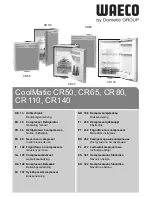
41
G
GB
B
Hints
Saving Energy
Pay careful attention to where the cabinet is placed.
See the section “Installation”. When installed
correctly the cabinet will consume less energy.
Try to avoid keeping the doors open for long periods
or opening the doors too frequently as warm air will
enter the cabinet and cause the compressor to
switch on unnecessarily often.
If the ambient temperature is high, the thermostat
knob is on the coldest setting (higher numbers) and
the appliance is fully loaded, the compressor may
run continuously, causing frost or ice to form on the
evaporator. If this happens, turn the knob to a
warmer setting (lower numbers) to allow automatic
defrosting and so a saving in electricity consumption.
Do not place warm foods inside the appliance. Allow
warm foods to cool first.
Keep the heat emitting condenser, the metall grille on
the rear wall of your appliance, always clean.
Hints for refrigeration
Do not store warm food or evaporating liquids in the
refrigerator and do cover or wrap up the food,
particularly if it has a strong smell.
To help you use your refrigerator correctly, here are some
useful hints:
Raw meat (beef, pork, lamb & poultry):
wrap in
polythene bags and place on top of the salad
compartment, this being the coldest spot in the
refrigerator.
Meat can only be stored safely in this way for
one or two days at the most.
Cooked food, cold cuts, jelly, etc.:
these should
be well covered and can be stored on any of the
glass shelves.
Fruit & vegetables:
these should be thoroughly
cleaned and placed in the bottom drawer/s.
Butter & cheese:
these should be placed in special
airtight containers or wrapped in aluminium foil or
polythene bags to keep out as much air as possible.
Milk bottles:
these should have a top and should be
stored in the bottle rack on the door.
Bananas, potatoes, onions and garlic, if not
packed, must not be kept in the refrigerator.
Maintenance
Unplug the appliance before carrying out any
maintenance operation.
Warning
This appliance contains hydrocarbons in its cooling unit
maintenance and recharging must therefore only be
carried out by authorised technicians.
Defrosting
Bleeding part of the moisture of cooling chamber in form
of frost and ice goes with the operation of the refrigerator.
Thick frost and ice has an insulating effect, so it reduces
cooling efficiency as the temperature increases, it needs
more energy, at a certain thickness it does not allow the
door of the frozen food compartment to open, possibly
the door can be broken.
At this type of appliance defrosting fresh food
compartment is automatic without any external
intervention.
The thermostatic control interrupts the operation of
compressor at regular intervals for more or less time -
during this cooling is interrupted - temperature of the
fresh food compartment increases and defrosting
occurs. After defrosting the thermostatic control restarts
operation of the system.
Melting water flows through defrost water outlet into the
evaporative tray maintained on the top of compressor and
evaporates due to warmth of it.
Check and clean the outlet of melting water
coming during defrosting regularly. If it is
clogged the melting water gathered can cause
earlier failure as it can go to the insulating of the
appliance.
Clean the melting water outlet with the supplied pipe
scraper that can be seen in the figure. The pipe scraper
has to be stored in the outlet.
Summary of Contents for ZBA 6154A
Page 25: ...25 N NL L 11 Plaats bedekking Hd op de smalle kant Hb totdat het op zijn plaats klikt ...
Page 37: ...37 F FR R 11 Enfoncez le cache Hd sur le petit carré Hb jusqu à ce qu il s enclenche en place ...
Page 49: ...49 G GB B 11 Fix cover Hd on the small square Hb until it clips into place ...
Page 50: ...50 G GB B N Za 22 09 ...
Page 51: ...51 G GB B ...
Page 52: ...200382917 00 03042009 933 016 014 www electrolux com ...












































